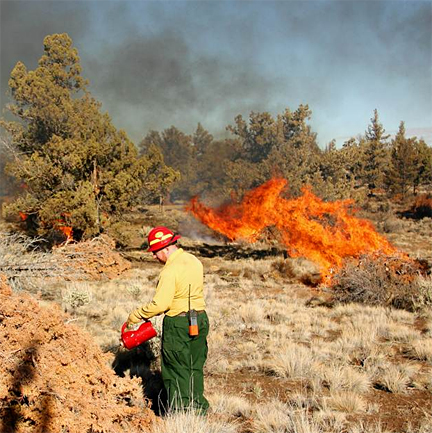You are here
Project Wildfire: A Community Approach to Surviving Wildfires
Project Wildfire in Deschutes County, Oregon has been recognized by the Centers for Disease Control and Prevention's (CDC) Office of Public Health Preparedness and Response’s (OPHPR) Learning Office and the CDC Foundation as a community effort that reflects and embodies FEMA’s Whole Community approach to emergency management.

Although central Oregon experiences other natural and man-made disasters, wildfires are by far the biggest threat here, especially during the summer months. In an average year, we experience 450 fires that burn 50,000 acres and homes, threaten lives and impact the economy. Following two devastating wildfires that burned in Bend, Oregon in 1990 and again in 1996, the Fire Chief of Deschutes County, Oregon, Gary Marshall, received a phone call from Safeco Insurance offering to contribute to the purchase of new firefighting equipment. Marshall politely declined Safeco’s offer because he had a more effective, long-term solution in mind that involved educating the public about the risks of wildfires.
Marshall asked Safeco Insurance if they would invest in an education program designed to teach people to help themselves prepare for wildfires. “A new piece of equipment might save one more home,” Marshall said. “But to really save homes, individuals have to take responsibility for their property before a fire.” His ultimate aim: To change the values and behaviors of citizens for generations to come.
Safeco agreed and FireFree was born. FireFree is a year-round educational program that was launched to promote 10 simple steps that homeowners can take to protect their homes from wildfires and reduce their risk of loss. The number one FireFree tip, and the main focus of the behavior change campaign, is to create “defensible space,” a minimum 30-foot buffer zone around a house that can be created in one weekend, and easily maintained. To encourage citizens to prepare for wildfires, FireFree partners with Deschutes County Department of Solid Waste and Deschutes Recycling to provide free collection and recycling of yard debris and waste during the spring. Later in the fall, residents can recycle their yard debris at Deschutes Recycling for half price. The program ran with this tagline, “It’s quick. It’s simple. It’s everybody’s responsibility.” Sixteen years later, FireFree continues to effectively change attitudes and behaviors about wildfires.
This initial program became part of a larger endeavor. County elected officials took notice of these efforts and passed a county ordinance that created Project Wildfire to help manage and support FireFree, as well as provide long-term wildfire mitigation strategies. At the core of Project Wildfire’s organization is a community driven approach, with a diverse membership that provides a wealth of local knowledge and broad educational outreach.
The FireFree story is just one of Project Wildfire’s accomplishments. Since the initial push in the late 1990s to educate communities in Deschutes County, Project Wildfire has become the local coordinating group that facilitates, educates, and disseminates efforts about the importance of wildfire safety across the community. Project Wildfire is the facilitator and caretaker of seven Community Wildfire Protection Plans (CWPPs), coordinates a countywide Sweat Equity (FireFree based) Program, and Evacuation Preparedness program and is recognized as a wildfire mitigation resource across the state and the nation.
While Project Wildfire has accomplished much over the last decade, our achievement is due in no small part to our successful working relationships with our partners. We continue to implement programs that encourage neighbor-to-neighbor education and understanding while leveraging opportunities for public-private partnerships.
The Whole Community Approach
The CDC Foundation, in partnership with CDC’s Office of Public Health Preparedness and Response, is contributing to the development and implementation of the Federal Emergency Management Agency’s (FEMA) Whole Community approach to emergency management. The “Whole Community” is FEMA’s philosophical approach on how to conduct emergency management in a way that integrates the needs, capabilities, and resources across the community. It attempts to engage the full capacity of the private and nonprofit sectors, including businesses, faith-based organizations, and the general public, in conjunction with the participation of federal, state, local, territorial, and tribal government partners.
Project Wildfire has been identified as one of seven programs to continue their Whole Community work during the pilot program period October 2012 – March 2013. During this time, we will provide a learning opportunity for CDC and CDC Foundation staff to gather information on what works well in starting and maintaining community programs, identifying strategies to create and build partnerships, and techniques to empower local action. The project findings will outline recommendations for fostering a Whole Community approach to emergency management, sustainability, and program replication.
We’re proud to be one of the seven community organizations selected as a promising example of FEMA’s Whole Community model. We look forward to highlighting the progress we’ve made toward preparedness in Deschutes County, Oregon and contributing to a national effort to make sure America is prepared for emergencies.
To learn more about Project Wildfire, please contact Kate Lighthall at klighthall@bendcable.com or visit us on the web at www.ProjectWildfire.org or www.FireFree.org.
View CDC's Public Health Matters Blog
Follow #PromisingExample on Twitter to learn about the other six communities that embody a whole community approach to emergency management.